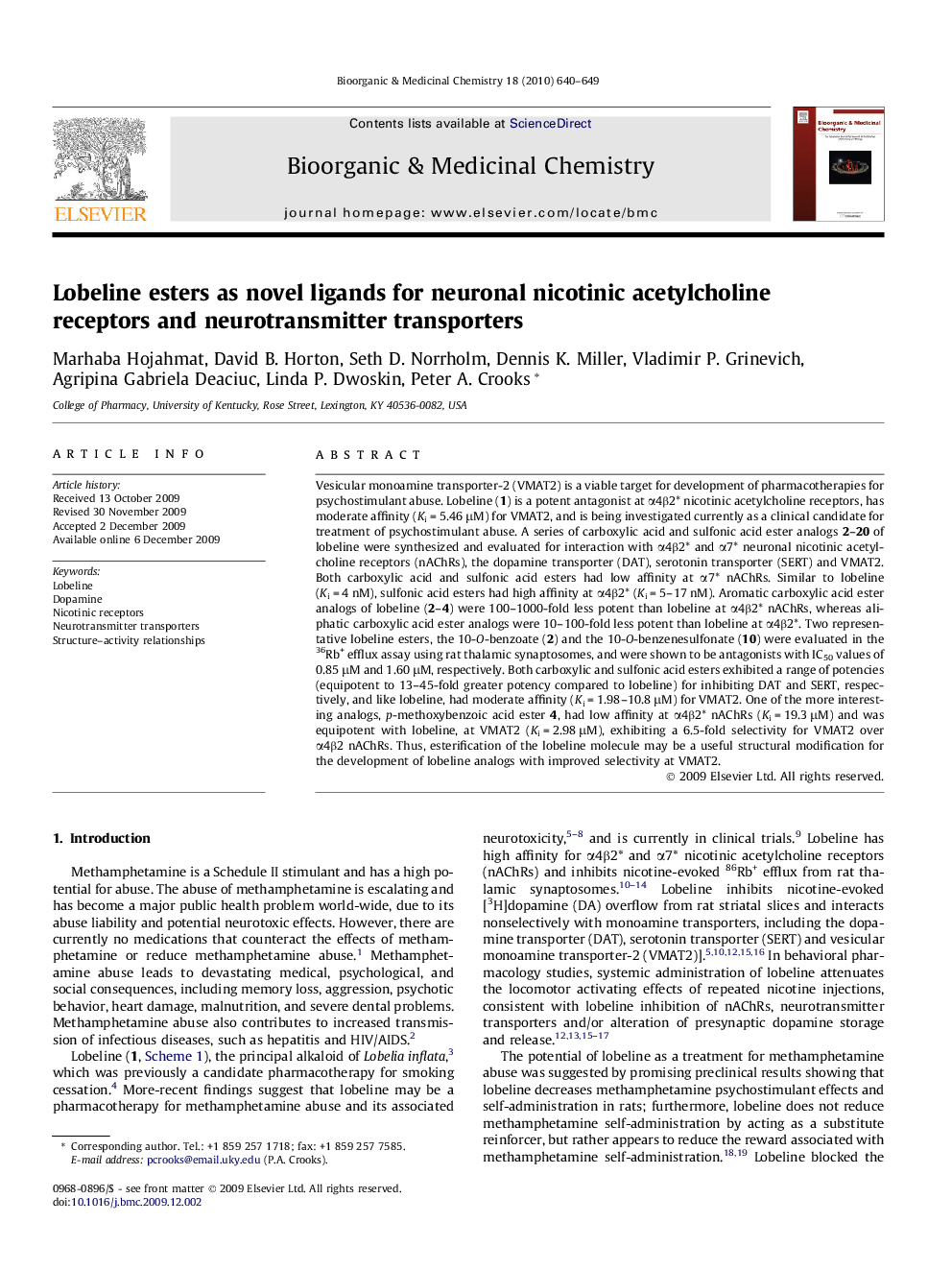| کد مقاله | کد نشریه | سال انتشار | مقاله انگلیسی | نسخه تمام متن |
|---|---|---|---|---|
| 1359636 | 981408 | 2010 | 10 صفحه PDF | دانلود رایگان |

Vesicular monoamine transporter-2 (VMAT2) is a viable target for development of pharmacotherapies for psychostimulant abuse. Lobeline (1) is a potent antagonist at α4β2∗ nicotinic acetylcholine receptors, has moderate affinity (Ki = 5.46 μM) for VMAT2, and is being investigated currently as a clinical candidate for treatment of psychostimulant abuse. A series of carboxylic acid and sulfonic acid ester analogs 2–20 of lobeline were synthesized and evaluated for interaction with α4β2∗ and α7∗ neuronal nicotinic acetylcholine receptors (nAChRs), the dopamine transporter (DAT), serotonin transporter (SERT) and VMAT2. Both carboxylic acid and sulfonic acid esters had low affinity at α7∗ nAChRs. Similar to lobeline (Ki = 4 nM), sulfonic acid esters had high affinity at α4β2∗ (Ki = 5–17 nM). Aromatic carboxylic acid ester analogs of lobeline (2–4) were 100–1000-fold less potent than lobeline at α4β2∗ nAChRs, whereas aliphatic carboxylic acid ester analogs were 10–100-fold less potent than lobeline at α4β2∗. Two representative lobeline esters, the 10-O-benzoate (2) and the 10-O-benzenesulfonate (10) were evaluated in the 36Rb+ efflux assay using rat thalamic synaptosomes, and were shown to be antagonists with IC50 values of 0.85 μM and 1.60 μM, respectively. Both carboxylic and sulfonic acid esters exhibited a range of potencies (equipotent to 13–45-fold greater potency compared to lobeline) for inhibiting DAT and SERT, respectively, and like lobeline, had moderate affinity (Ki = 1.98–10.8 μM) for VMAT2. One of the more interesting analogs, p-methoxybenzoic acid ester 4, had low affinity at α4β2∗ nAChRs (Ki = 19.3 μM) and was equipotent with lobeline, at VMAT2 (Ki = 2.98 μM), exhibiting a 6.5-fold selectivity for VMAT2 over α4β2 nAChRs. Thus, esterification of the lobeline molecule may be a useful structural modification for the development of lobeline analogs with improved selectivity at VMAT2.
A series of carboxylate and sulfonate esters of lobeline have been synthesized. The sulfonate esters exhibited high affinity (Ki = 5–17 nM), at α4β2∗ nicotinic receptors, but were less active as inhibitors of neurotransmitter transporters. The carboxylate esters had lower affinity at α4β2∗ nicotinic receptors (0.06–19.3 μM) and moderate affinity and selectivity at neurotransmitter transporters.Figure optionsDownload as PowerPoint slide
Journal: Bioorganic & Medicinal Chemistry - Volume 18, Issue 2, 15 January 2010, Pages 640–649